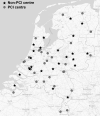Treatment patterns of non-ST-elevation acute coronary syndrome patients presenting at non-PCI centres in the Netherlands and possible logistical consequences of adopting same-day transfer to PCI centres: a registry-based evaluation
- PMID: 30684141
- PMCID: PMC6439038
- DOI: 10.1007/s12471-019-1229-2
Treatment patterns of non-ST-elevation acute coronary syndrome patients presenting at non-PCI centres in the Netherlands and possible logistical consequences of adopting same-day transfer to PCI centres: a registry-based evaluation
Abstract
Background: European Society of Cardiology (ESC) guidelines recommend same-day transfer to a percutaneous coronary intervention (PCI) centre for angiography in high-risk (ESC-HR) patients with non-ST-elevation acute coronary syndrome (NSTE-ACS). We describe the treatment patterns of NSTE-ACS patients presenting at non-PCI centres and evaluate the logistical consequences of adopting same-day transfer.
Methods: From August 2016 until January 2017, all consecutive NSTE-ACS patients presenting at 23 non-PCI centres in the Netherlands were recorded. We built an online case report form in collaboration with the National Cardiovascular Database Registry to collect information on risk stratification by the attending physician, timing and location of angiography, and treatment.
Results: We included 871 patients (mean age 69.1 ± 12.8). 55.8% were considered ESC-HR. Overall, angiography at non-PCI centres was 55.1% and revascularisation was 54.1%. Among ESC-HR patients, angiography at non-PCI centres was 51.4% and revascularisation was 54.9%. Angiography <24 h was 55.6% in patients with angiography at a non-PCI centre and 74.3% in patients with angiography at a PCI-centre. Assuming patients would receive similar treatment, adoption of same-day transfer would increase transfers of ESC-HR patients who undergo PCI (44.3%), but also increases transfers of medically treated patients (36.2%) and patients awaiting coronary bypass artery grafting (9.1%).
Conclusions: In this registry of NSTE-ACS patients at non-PCI centres, the majority of ESC-HR patients underwent angiography at a non-PCI centre. Same-day transfer occurred in one-quarter of the ESC-HR patients, despite guideline recommendation. Nonselective adoption of same-day transfer to a PCI centre would increase transfers of ESC-HR patients who undergo PCI, however, equally increases transfers of patients who are medically treated.
Keywords: Non-ST-elevation acute coronary syndrome; PCI; coronary angiography; same-day transfer.
Conflict of interest statement
N.P.G. Hoedemaker, P. Damman, H.A. Bosker, P.W. Danse, A.H. Liem, B. Geerdes, H. van Laarhoven, R.J. de Winter and The NVVC NSTEMI-ACS project group declare that they have no competing interests.
Figures




References
-
- Roffi M, Patrono C, Collet JP, et al. 2015 ESC guidelines for the management of acute coronary syndromes in patients presenting without persistent ST-segment elevation: Task Force for the Management of Acute Coronary Syndromes in Patients Presenting without Persistent ST-Segment Elevation of the European Society of Cardiology (ESC) Eur Heart J. 2016;37:267–315. doi: 10.1093/eurheartj/ehv320. - DOI - PubMed
LinkOut - more resources
Full Text Sources
Miscellaneous

